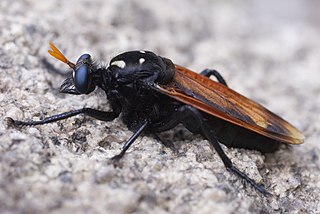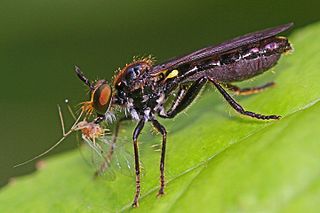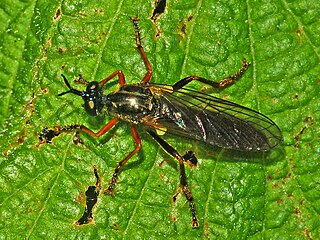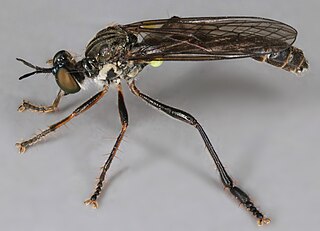
Flies are insects of the order Diptera, the name being derived from the Greek δι- di- "two", and πτερόν pteron "wing". Insects of this order use only a single pair of wings to fly, the hindwings having evolved into advanced mechanosensory organs known as halteres, which act as high-speed sensors of rotational movement and allow dipterans to perform advanced aerobatics. Diptera is a large order containing an estimated 1,000,000 species including horse-flies, crane flies, hoverflies and others, although only about 125,000 species have been described.

The Asilidae are the robber fly family, also called assassin flies. They are powerfully built, bristly flies with a short, stout proboscis enclosing the sharp, sucking hypopharynx. The name "robber flies" reflects their expert predatory habits; they feed mainly or exclusively on other insects and, as a rule, they wait in ambush and catch their prey in flight.

Forensic entomology has three sub-fields: urban, stored product and medico-criminal entomologies. This article focuses on medico-criminal entomology and how DNA is analyzed with various blood-feeding insects.

Leptarthrus is a genus of robber-flies, Most species are found throughout Europe, and there is one Chinese species.

Tachina grossa or giant tachinid fly is a very large tachinid fly.

Dioctria atricapilla, the violet black-legged robber fly, is a species of robber fly in the subfamily Dasypogoninae. This 9- to 12-millimeter long insect has a wingspan of roughly 7 to 9 mm and short, three-segmented antennae. It's a predatory insect, feeding mainly on smaller flies and predatory hymenopterans. It primarily thrives in grassland, and is seen from May to July.

Gymnosoma clavatum is a species of tachinid flies in the genus Gymnosoma of the family Tachinidae.

Choerades is a genus of robber flies described by Francis Walker in 1851, belonging to the family Asilidae, subfamily Laphriinae.

Prolepsis is an insect genus of mainly neotropical Diptera in the family Asilidae or robber flies.

Diogmites is a genus of mainly neotropical flies in the family Asilidae or robber flies.

Neoitamus cyanurus, the common awl robberfly, is a species of 'robber fly' belonging to the family Asilidae.

Eudioctria is a genus of robber flies in the family Asilidae. There are about 14 described species in Eudioctria.

Dioctria rufipes, the common red-legged robberfly, is a species of robber fly in the subfamily Dasypogoninae of the family Asilidae.

Cyrtopogon ruficornis is a species of fly in the robber flies family. It is found in parts of Central and Southern Europe.

Stilpnogaster aemula is a species of 'stiletto flies' belonging to the family Asilidae.

Machimus setibarbus is a species of fly in the family Asilidae, the robber flies and assassin flies.

Cerdistus erythrurus is a species of robber fly in the subfamily Asilinae. It is the type species of the genus Cerdistus.

Neomochtherus geniculatus is a species of fly in the robber fly family, Asilidae.

Choerades marginata is a species of robber fly found in Europe.

Dioctria hyalipennis is a Holarctic species of robber fly in the family Asilidae.



















